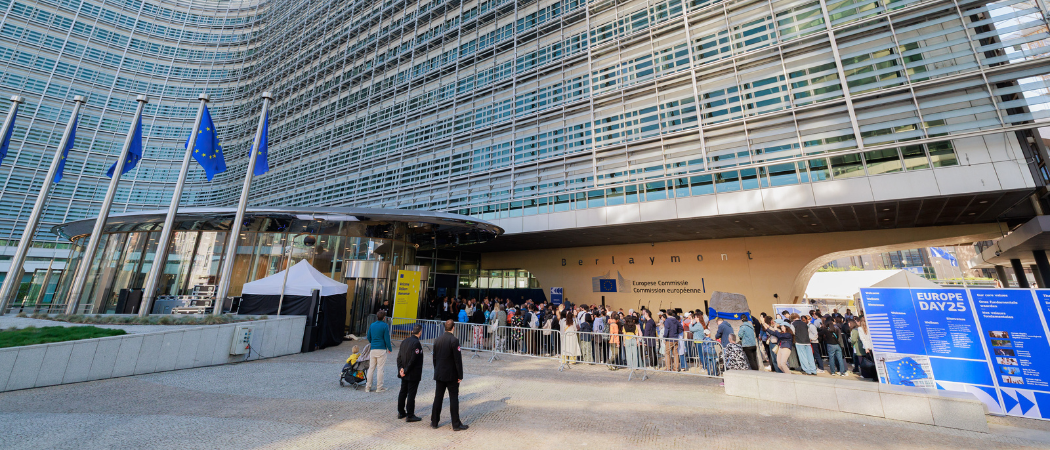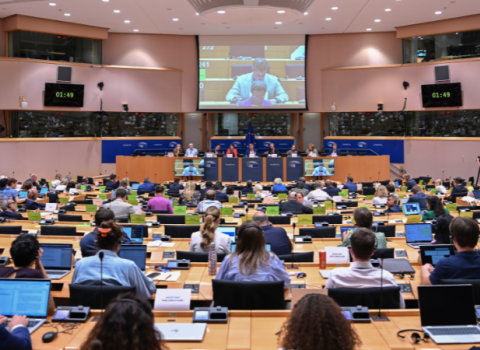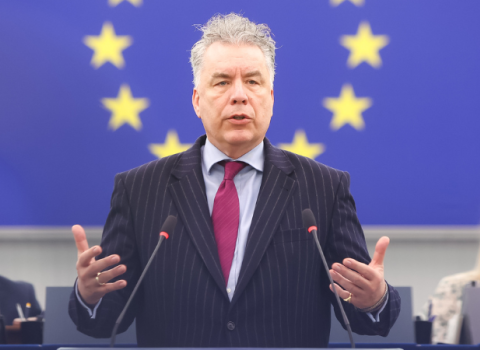EU’s next research Framework Programme will have four pillars and parts of it are to be aligned more closely with the European Competitiveness Fund

Christophe Licoppe / European Union
Collaborative research in Horizon Europe is set to be rebranded after 2028 and will be managed through a “steering mechanism” and a “competitiveness coordination tool” which will be detailed in the regulation of the European Competitiveness Fund (ECF), a leaked FP10 proposal has revealed.
According to the draft text by the European Commission dated July 4, the next Framework Programme for research and innovation will adopt a new four-pillar structure but some of its components – collaborative research in particular – will be strategically aligned with the ECF.
The four pillars are excellent science, competitiveness and society, innovation, and European research area, with the second pillar set to be tightly connected to the ECF. The draft proposal says the competitiveness pillar “shall include the collaborative research and innovation activities in a specific dedicated part of the work programmes” which will be developed “under the steering mechanism and the Competitiveness Coordination Tool” which are set up in the new ECF regulation.
The Brussels rumour mill has been churning out scenarios for how FP10 and the ECF will work together for months, but the draft proposal does not clarify sufficiently how the shared jurisdiction over the new competitiveness pillar will be managed.
German centre-right MEP Christian Ehler, who is slated to become the European Parliament’s rapporteur on the FP10 legislation, told Science|Business that, through the ECF, the Commission is attempting “a power grab instead of the reform we need according to the Draghi and Heitor [policy reports].”
Commission President Ursula von der Leyen had previously said that FP10 would remain independent but would still be ‘tightly connected’ to the ECF, which would “offer support for the investment journey of a project, from an idea to the market, from research to start-up, scale-up and global manufacturing.”
However, there are some positive developments, said Ehler. “The Commission seems serious about leaving more space for researchers to come up with bottom-up ideas under more openly formulated calls.”
The draft proposal does not include details on the budget, but research stakeholders have been advocating for as much as €200 billion.
“If this is the final text, we will have to see this in the context of the whole MFF package, but it seems to me that there will be a lot on the shoulders of the co-legislators to make these texts work for [research] stakeholders,” Ehler said.
The Commission is expected to unveil its final proposal for the next long-term EU budget, including the ECF and Horizon Europe, on July 16.
What’s in the draft proposal?
Pillar 1, an expanded ERC
According to the draft, Horizon Europe’s Pillar 1 will continue to fund basic science under two funding schemes: the European Research Council (ERC) and the Marie Skłodowska-Curie Actions (MSCA).
But starting in 2028, the two funds will have a stronger focus on attracting and keeping talent in Europe. “Research excellence and mobility is at the core of Europe’s ambition to be the best place in the world to do research: ‘Choose Europe’,” the draft says.
The draft promises the ERC will expand to increase its support for fundamental research, but provides no further details. It could introduce new or bolstered support schemes, and a bigger budget than its current €16 billion for seven years.
There is no mention of the research training programme, MSCA, getting a budget boost. It will continue to fund doctoral networks, post-doctoral fellowships and R&I staff exchanges, as per the draft. The draft also mentions “support mechanisms to foster sustainable careers”, likely a nod to the Choose Europe scheme which the Commission will pilot this year.
Research infrastructures will no longer be funded under Pillar 1, instead moving to the newly created Pillar 4.
Pillar 2 and the competitiveness fund
Despite some rumours to the contrary, FP10 will have a Pillar 2 to supports collaborative research and innovation, but it will hold a different name (“Competitiveness and Society”) and will be closely tied to the ECF.
A first, “competitiveness” component would fund research and innovation to support the ECF’s four proposed policy areas: clean transition and industrial decarbonisation; health, bioeconomy and biotechnology; digital; and resilience, defence and space. It is unclear whether this means Pillar 2 will also fund defence and dual-use projects.
A second, “society” component would support “bottom-up research” on societal challenges such as migration, democracy and disinformation. This component would also incorporate research and innovation support for the EU missions and the New European Bauhaus Facility.
Within Pillar 2, the Commission plans to establish a “limited number” of partnerships, which will be “radically simplified.” The draft says the Competitiveness Fund should contribute to the partnerships “when necessary” to complete its objectives. The leaked proposal does not specify whether the three different types of partnerships will all continue, but the largest partnerships, known as joint undertakings, are mentioned.
In addition to the continuation of the missions, the introduction to the draft regulation says Horizon Europe “could finance research and innovation related aspects of ‘moonshots’ projects with a strong scientific component.” Potential examples of moonshots include investing in CERN’s Future Circular Collider project, developing clean aviation and quantum computing.
EIC dominates Pillar 3
Pillar 3, “Innovation” instead of “Innovative Europe,” will continue to support innovation. Its funding will be mainly funnelled through the European Innovation Council (EIC), which is in for a revamp modelled after ARPA, the US advanced research agencies.
The EIC will keep the same funding schemes as before: Pathfinder, Transition, Accelerator and scale-up funding. It will also fund incentives for innovation procurers and business acceleration services.
Imitating elements of ARPA, the EIC will support high risk projects in stages, with the option to discontinue them, “based on their potential to deliver on disruptive solutions as assessed by expert programme managers.”
To support defence and dual use start-ups and scale-ups, the EIC will try to copy the approach of the US defence research agency DARPA.
Some innovation support will be available outside of the EIC through innovation ecosystem activities, but the draft does not specify what these are.
The draft does not specifically mention the European Institute of Innovation and Technology (EIT), but it suggests Horizon will continue to foster the EIT’s mission of integrating the so-called knowledge triangle of higher education, research and innovation, and business.
Welcoming Pillar 4
The newly created Pillar 4 will support the development of a unified European Research Area (ERA) through three funding schemes: ERA policy, research and technology infrastructures, and Widening participation and spreading excellence.
The Widening scheme will continue to help emerging EU member states improve their R&D systems. The programme could now separate beneficiary countries into two categories: Widening and Transition countries. The latter are former Widening countries whose R&D performance has already improved.
Both groups will receive support for networking, knowledge valorisation and countering brain drain. Widening countries will also get extra support for capacity building.
Separately, another novelty, Horizon will fund both research and technology infrastructures. EU will also contribute up to 20% towards the building costs of critical world-class facilities.





 A unique international forum for public research organisations and companies to connect their external engagement with strategic interests around their R&D system.
A unique international forum for public research organisations and companies to connect their external engagement with strategic interests around their R&D system.